How to Check Your Transmission Fluid: 7 Basic Steps
-

- Last updated:

Even uneducated car owners often know well enough to look at their vehicle’s oil level, but it isn’t the only critical fluid check you should be regularly performing.
You can’t forget to check your transmission fluid—the vital lubricant and hydraulic liquid that powers the transmission and keeps the gears and torque converter working. Fall behind on this essential maintenance task, and you could end up with an inconvenient breakdown and expensive transmission repairs.
Don’t wait until that first gear grinds or slips before you start paying attention to your transmission fluid. Follow these basic steps to check your transmission fluid, and you’ll ensure more reliable performance and fewer service appointments for your car.
Before You Start
Before checking your transmission fluid, note that many recent vehicles from Chrysler, Audi, BMW, and a growing group of manufacturers don’t have transmission fluid dipsticks. Advances in sealed systems have taken away much of the need for regular fluid checks and changes. Making the system more complicated also makes it harder for DIYers to screw up their transmissions by adding the wrong kind or amount of fluid.
Attempting to check or adjust transmission fluid without a dipstick generally involves raising the vehicle and using specialty equipment, so skip the hassle and take it to a mechanic if you think you’re having transmission trouble. Following the factory instructions and recommendations for your particular model is crucial. Even if you do have a dipstick, your model likely has specific transmission fluid testing procedures you must follow to protect your car.
The 7 Easy Steps for Checking Your Transmission Fluid
1. Turn the Car On
Position your car on a level service, put it in park or neutral, and engage the parking brake. Leave the engine running and let it warm up for several minutes.

Do You Check Transmission Fluid Hot or Cold?
Look at your vehicle’s manual to see whether you should check your transmission fluid hot or cold. Some vehicles, such as some Hondas, require the engine to be off. Referencing the vehicle manual will be crucial to ensure you get accurate fluid readings and use the correct transmission fluid to refill it.
2. Locate the Transmission Fluid Dipstick
When the engine is warm, pop the hood and locate the transmission fluid dipstick. In vehicles with in-line engines, the dipstick is usually behind the oil dipstick, sitting closer to the rear of the engine towards the windshield. In a front-wheel-drive vehicle, the dipstick usually sits in the transaxle to the right of the oil dipstick.
The dipstick should have a label indicating that it’s for transmission fluid. It’s often a bright red or yellow color for easy identification.
If you have a manual transmission, you will need to elevate the vehicle on a hoist. You or your mechanic will need to reach a drain plug, which is generally only accessible by raising the car.
3. Remove the Dipstick and Wipe Clean
Take the dipstick out of the reservoir and wipe it off with a clean rag. You can check the fluid at this point to assess its condition and determine if it’s ready for replacement.
With rubber gloves on, dip your fingertip in the transmission fluid and gently rub it between your fingers. You’re checking for a clear, pinkish liquid, one free of dirt, metal shavings, and other contaminants that would indicate issues in the system.
Wipe the fluid off the dipstick with a clean cloth.

4. Insert and Remove the Dipstick
After cleaning the transmission fluid dipstick, carefully reinsert it as far as it will go. Pull it back out and assess the fluid level.
5. Check the Fluid Level
Towards the low end of the dipstick, you will find two markings, a “full” mark, and a “low” mark. If the fluid doesn’t reach the “full” line, you’ll need to refill your transmission fluid.
Checking your transmission fluid while the car is warm is crucial because the fluid expands as it heats, affecting the final reading. When you check cold transmission fluid, you may get an inaccurately low reading and accidentally overfill your car.
Check both sides of the dipstick and compare the measurements, erring on the side of the lower reading. Perform a few additional tests to ensure accuracy.

6. Refill Transmission Fluid as Needed
Different vehicles use different transmission fluids with varying viscosities and other properties. A service center will have the appropriate product on hand, and you’ll have peace of mind working with a knowledgeable professional.
If you plan to refill the transmission fluid yourself, follow the manufacturer’s recommendations on selecting the proper fluid. Insert a funnel into the dipstick tube. Add transmission fluid a little bit at a time, being careful not to spill transmission fluid on the hot engine. Let it settle for a few minutes and then take a reading to ensure you don’t overfill it. Refill and repeat as needed.
7. Visit a Service Center for Transmission Fluid Leaks
Low transmission fluid isn’t always an immediate cause for concern, but it’s not a common issue in closed systems like a transmission. After refilling your transmission fluid, check it daily to see if the levels are changing.
Low levels a day after a refill means you have a transmission fluid leak somewhere. Check under the car for a leak around the transmission. In a front-wheel-drive(FWD) vehicle, it usually sits in the center and runs toward the engine.
A pool of pinkish-red oily fluid is a dead giveaway that there’s a cracked component or broken seal somewhere. If you don’t see any drips, you still shouldn’t rule out a leak. Transmission fluid may be filling gaps in the transmission, transfer case, or any number of places without leaking onto the ground. It’s crucial to visit a service center when you have low fluid levels, whether you see a leak or not.
Even if your fluid levels are correct and there’s no indication of a leak, the transmission fluid quality may need attention. Unhealthy transmission fluid may indicate old age or transmission issues that could cause breakdowns in the future.

What Does Clean Transmission Fluid Look Like?
Most transmission fluid in modern automatic vehicles is a bright pink or red color. The consistency will be smooth and oily, with a texture thinner than motor oil.
As it ages, it’s common for transmission fluid to darken or dull to a brown color, a fair indication that it’s time for a change. A dark black or brown color means it’s burnt, likely as the result of some transmission problem. It will usually have a burnt smell as well.
Transmission fluid can also thicken with age, but when you check the consistency, the main thing you’re looking for is contamination. Healthy transmission fluid is clear. If you find grit, metal shavings, or other debris in the oil, you have transmission components wearing down or a leak letting in dirt. Take your car in for service immediately if you have burnt or contaminated transmission fluid.
When Should You Check Your Transmission Fluid?
You should check your transmission fluid at least once every 6 months if your car is functioning properly. If your car is giving you signs of transmission trouble, you should check the levels and fluid quality as soon as possible. Some signs of low fluid or transmission troubles include:
- Slipping or grinding gears
- Trouble accelerating and delayed shifts
- Odd odors, clunking noises, or vibrations
- Transmission overheating
Along with topping off your fluids at every service appointment, you should flush and replace your transmission fluid once every 30,000–50,000 miles. In a modern vehicle without a dipstick, your fluid should last as long as the transmission (around 150,000 miles or more).

 Final Thoughts
Final Thoughts
Transmission fluid checks are one maintenance task you should never skip. Finding transmission fluid issues early through regular checks is one of the easiest ways you can prevent expensive repairs and prolong the life of your vehicle. Review your vehicle instructions to learn how to check the transmission fluid in your car, and follow these basic steps to ensure your ride is reliable and ready for action.
See also:
Featured Image Credit: Devolk, Pixabay
Contents


